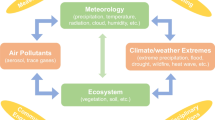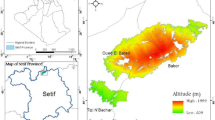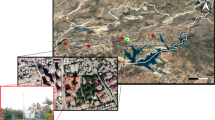Abstract
This paper analyzes the regional differences in dust weather and its relationship with climatic factors and vegetation cover, using data at 27 observation stations in the Beijing-Tianjin Sand Source Region from 1960 to 2007. There was a decreasing trend in dust weather in the southeast, which was correlated with wind and temperature. In contrast, in the northwest, the number of dusty days did not decrease and was significantly correlated with precipitation and vegetation cover. These results suggest that, in addition to the climate and underlying conditions, physical geographic conditions also influenced the frequency of dust weather.









Similar content being viewed by others
References
Carlson TN, Ripley DA (1997) On the relation between NDVI, fractional vegetation cover, and leaf area index. Remote Sens Environ 62:241–252
CCMB (China Central Meteorological Bureau) (1979) Standard on weather observation. Meteorological Press, Beijing, p 186
Gao QX, Su FQ, Ren ZH (2002) Dust weather and its influences of Beijing (in Chinese). China Environ Sci 22(5):468–471
Gao SY, Zhang CL, Zou XY, Wu YQ, Shi S, Li HD (2008) Benefits of Beijing-Tianjin sand source control engineering. Science Press, Beijing, pp 1–10
Goudie A (1983) Dust storms in space and time. Prog Phys Geogr 7:502–530
Goudie A (2009) Dust storms: recent developments. J Environ Manag 90:89–94
Goudie A, Middleton NJ (1992) The changing frequency of dust storms through time. Clim Chang 20:197–225
Idso S (1974) Thermal blanketing: a case for aerosol-induced climatic alteration. Science 186:50–51
Idso S, Brazel A (1977) Planetary radiation balance as a function of atmospheric dust: climatological consequences. Science 198:731–733
Kurosaki Y, Mikami M (2005) Regional difference in the characteristic of dust event in east asia: relationship among dust outbreaks, surface wind, and land surface condition. J Meteorol Soc Jpn 83A:1–18
Li JC, Dong ZB, Wang XM, He SS (2008) Seasonal distribution and causes of dust events in Tarim Basin, China. J Desert Res 28:142–148
Lin ZH, Chen H, Zhang SH, Xu XK (2004) Climatic and environmental background for the anomalous spring sandstorms over the northern China during 2003. Clim Environ Res 9:191–202
Littmann T (1991) Dust storm frequency in Asia: climatic control and variability. Int J Climatol 11:393–412
Littmann T, Steinrucke J (1989) Atmospheric boundary conditions of recent Saharan dust influx into Central Europe. geoj. 18:399–406
Maisongrande P, Uchemin B, Dedieu G (2004) VEGETATION/SPOT: an operational mission for the Earth monitoring; presentation of new standard products. Int J Remote Sens 25:9–141
Parungo F, Li Z, Li X, Yang D (1994) Gobi dust storms and the Great Green Wall. Geophys Res Lett 21:999–1002
Pye K (1987) Aeolian dust and dust deposits. Academic Press, London
Qian WH, Quan LS, Shi SY (2002) Variations of the dust storm in China and its climatic control. J Clim 15:1216–1229
Quan LS, Shi SY, Zhu YF, Qian WH (2001) Temporal-spatial distribution characteristics and causes of dust-days in China. Acta Geogr Sinica 56:477–485
Wang SG, Yang M, Qi B, Xin CL, Yang MF (1999) Influence of sand-dust storms occurring over the Gansu Hexi district on the air pollution in Lanzhou city (in Chinese). J Desert Res 19(4):354–358
Wang XM, Dong ZB, Zhang JW et al (2004) Modern dust storms in China: an overview. J Arid Environ 58:559–574
Ye DZ, Chou JF, Liu JY et al (2000) Causes of sand-stormy weather in northern China and control measures. Acta Geogr Sinica 55:513–521
Zhai PM, Li XY (2003) On climate background of dust storms over northern China. Acta Geogr sin 58S:125–131
Zhang DE (1984) A preliminary analysis to the climatology of the dust deposition in the historical periods of China. Sci China (Series B) 3:278–288
Zhang J, Guo N, Di XH (2004) Analysis on precipitation in winter and relation with sand days in northwest region. J Desert Res 24:603–606
Zhou XK, Zhai PM (2004) Relationship between vegetation coverage and spring dust storms over northern China. J Geophys Res 109:D03104. doi:10.1029/2003JD003913
Zhou ZJ, Zhang GC (2003) Typical severe dust storms in northern China during 1954–2002. Chin Sci Bull 48:1224–1228
Zhou ZJ, Zhang GC, Ai WX, Zhang HZ, Niu RY (2006) Time series of spring dust emission and its correlative climatic factors in northern China. J Desert Res 26:935–941
Acknowledgments
This research was supported by the National Natural Science Foundation of China (Grant No. NSFC40601091) and the Key Projects in the National Science & Technology Pillar Program during the Eleventh Five-year Plan Period (Grant No. 2006BAD20B02). The authors especially thank the Group of Drought & Risk Governance from Beijing Normal University for their technical support and greatly improving the language in this paper. We also thank the editor and anonymous reviewers for their constructive comments and improvement of the manuscript.
Author information
Authors and Affiliations
Corresponding author
Rights and permissions
About this article
Cite this article
Wu, J., Zhao, L., Zheng, Y. et al. Regional differences in the relationship between climatic factors, vegetation, land surface conditions, and dust weather in China’s Beijing-Tianjin Sand Source Region. Nat Hazards 62, 31–44 (2012). https://doi.org/10.1007/s11069-011-0039-7
Received:
Accepted:
Published:
Issue Date:
DOI: https://doi.org/10.1007/s11069-011-0039-7




